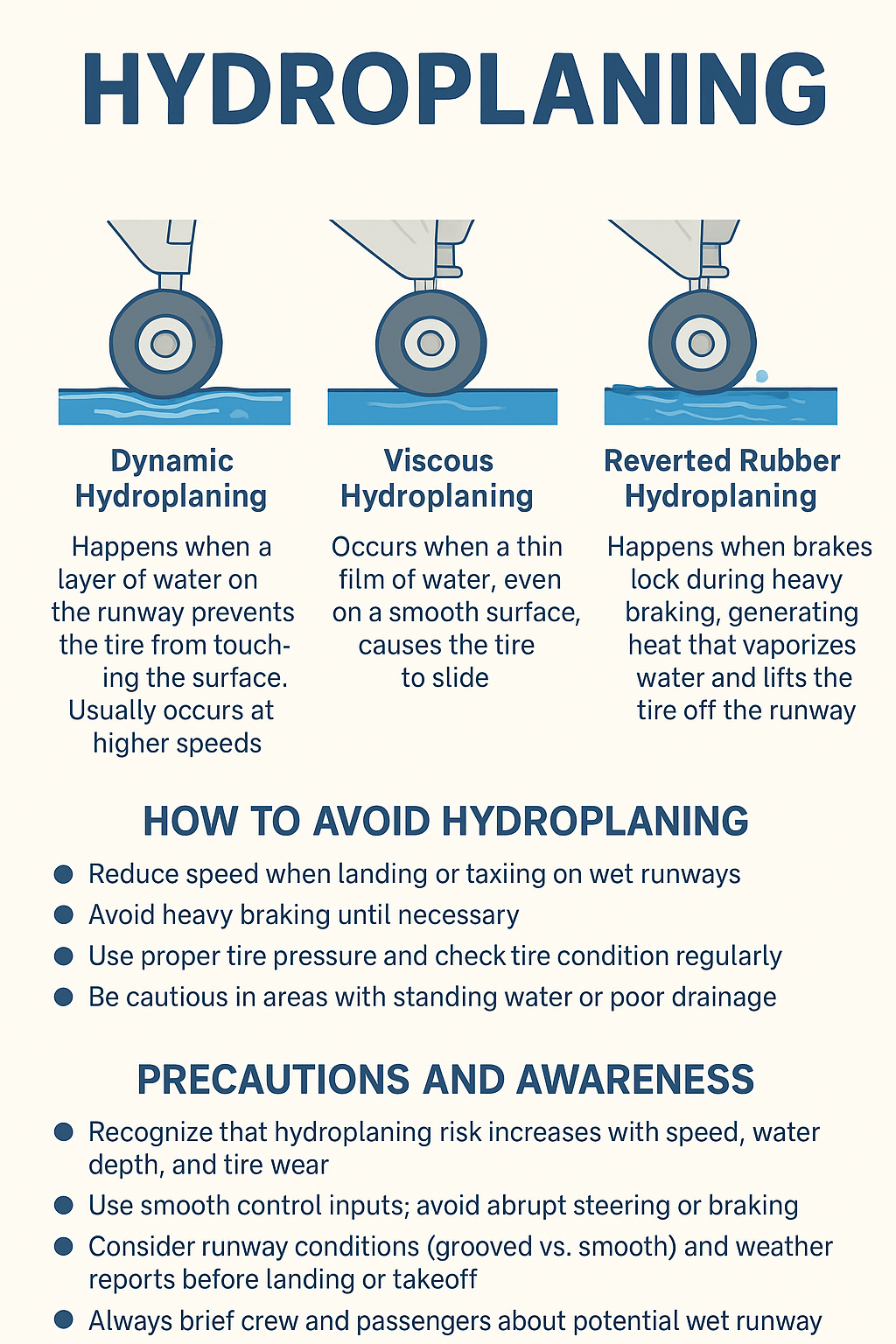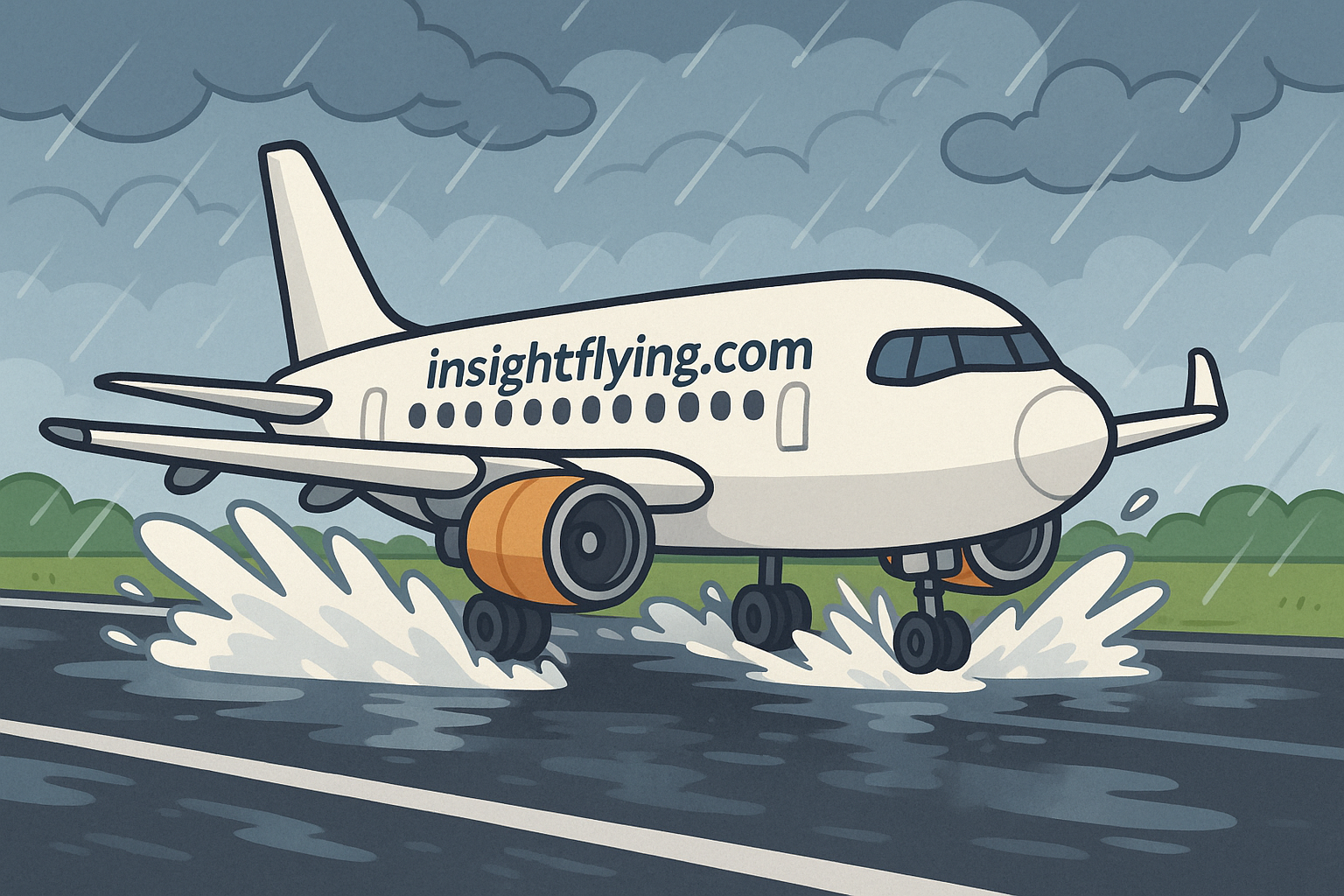Hydroplaning Explained
Hydroplaning occurs when a layer of water builds up between an aircraft’s tires and the runway surface, causing the tires to lose direct contact with the ground. This results in a loss of traction, making steering, braking, and acceleration less effective, and can be particularly dangerous during takeoff or landing.
การเกิด Hydroplaning
Hydroplaning เกิดขึ้นเมื่อมีน้ำสะสมอยู่ระหว่างยางล้อของเครื่องบินกับพื้นรันเวย์ ทำให้ยางล้อสูญเสียการสัมผัสโดยตรงกับพื้น ซึ่งส่งผลให้แรงเสียดทานลดลง การบังคับเลี้ยว การเบรก และการเร่งความเร็วมีประสิทธิภาพลดลง ทำให้มีความเสี่ยงสูง โดยเฉพาะช่วงการบินขึ้นหรือลงจอด

Types of Hydroplaning
- Dynamic Hydroplaning – Happens when a layer of water on the runway prevents the tire from touching the surface. Usually occurs at higher speeds.
- Viscous Hydroplaning – Occurs when a thin film of water, even on a smooth surface, causes the tire to slide. It can happen at lower speeds compared to dynamic hydroplaning.
- Reverted Rubber Hydroplaning – Happens when brakes lock during heavy braking, generating heat that vaporizes water and lifts the tire off the runway.
ประเภทของ Hydroplaning
- Dynamic Hydroplaning – เกิดเมื่อมีชั้นน้ำบนรันเวย์ป้องกันไม่ให้ยางล้อสัมผัสพื้น มักเกิดที่ความเร็วสูง
- Viscous Hydroplaning – เกิดเมื่อมีฟิล์มน้ำบาง ๆ บนพื้นเรียบ ทำให้ยางล้อเลื่อนได้ แม้ความเร็วต่ำกว่าการเกิด dynamic hydroplaning
- Reverted Rubber Hydroplaning – เกิดเมื่อเบรกล็อกขณะเบรกแรง ทำให้เกิดความร้อนและน้ำระเหยยกยางขึ้นจากพื้น
How to Avoid Hydroplaning
- Reduce speed when landing or taxiing on wet runways.
- Avoid heavy braking until necessary.
- Use proper tire pressure and check tire condition regularly.
- Be cautious in areas with standing water or poor drainage.
วิธีป้องกัน Hydroplaning
- ลดความเร็วขณะลงจอดหรือวิ่งบนรันเวย์เปียก
- หลีกเลี่ยงการเบรกแรงโดยไม่จำเป็น
- ตรวจสอบความดันลมยางและสภาพยางอย่างสม่ำเสมอ
- ระวังบริเวณที่มีน้ำขังหรือระบบระบายน้ำไม่ดี
Precautions and Awareness
- Recognize that hydroplaning risk increases with speed, water depth, and tire wear.
- Use smooth control inputs; avoid abrupt steering or braking.
- Consider runway conditions (grooved vs. smooth) and weather reports before landing or takeoff.
- Always brief crew and passengers about potential wet runway operations.
ข้อควรระวังและการรับรู้
- รับรู้ว่า hydroplaning มีความเสี่ยงมากขึ้นเมื่อความเร็ว น้ำบนรันเวย์ลึก หรือยางสึกหรอ
- ใช้การควบคุมเครื่องบินอย่างนุ่มนวล หลีกเลี่ยงการเลี้ยวหรือเบรกกะทันหัน
- พิจารณาสภาพรันเวย์ (มีร่องน้ำ vs. เรียบ) และรายงานสภาพอากาศก่อนลงจอดหรือบินขึ้น
- แจ้งลูกเรือและผู้โดยสารเกี่ยวกับการปฏิบัติบนรันเวย์เปียก
